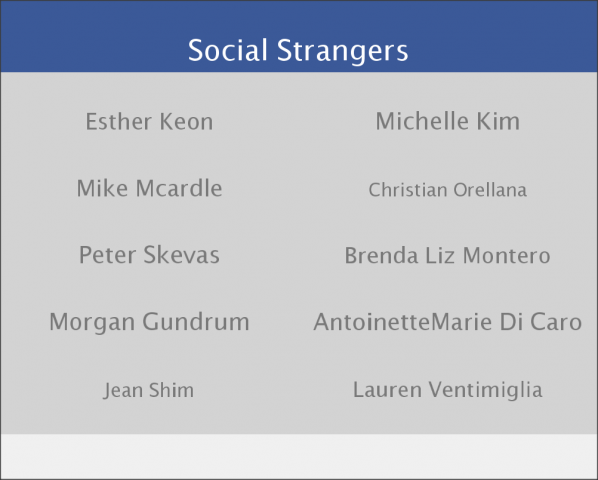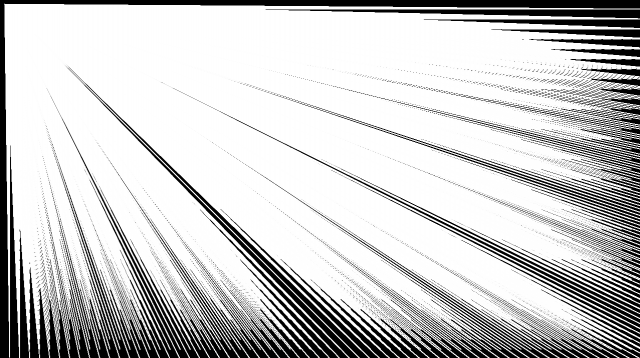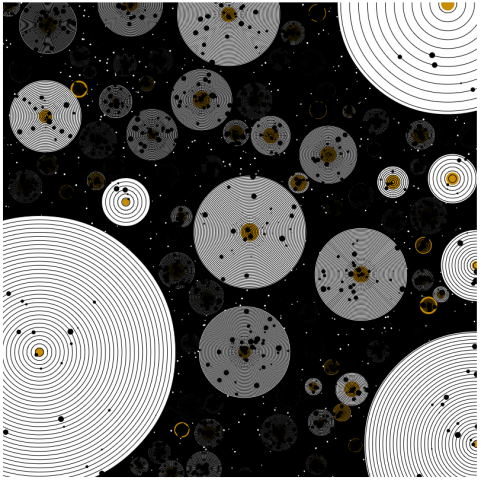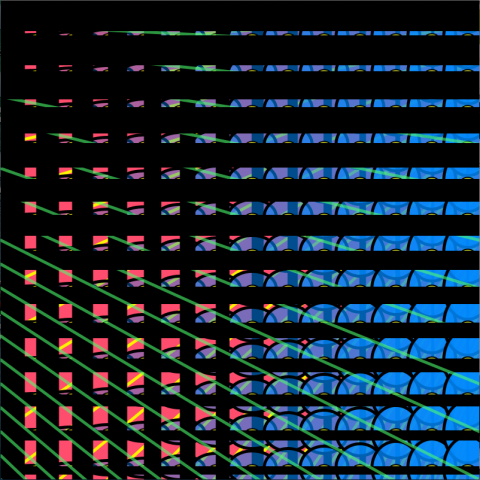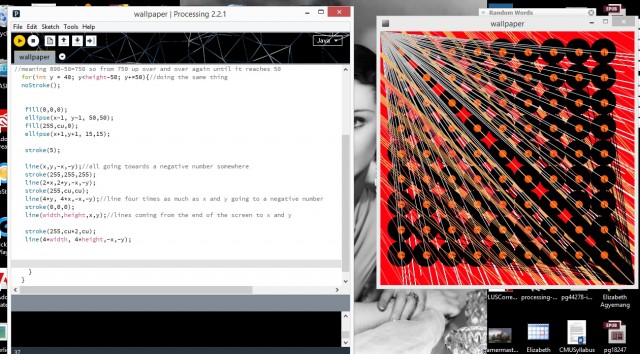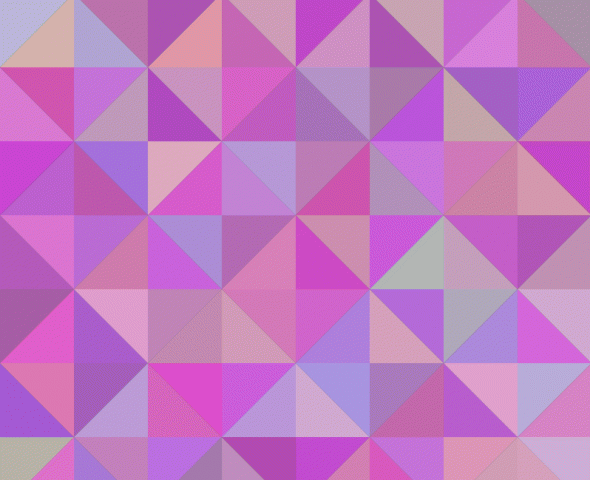Iteration – My Least Interactive Friends
The generative image shown below is a composite of the names of my ten least interactive Facebook friends. By first downloading and parsing the html data from my Facebook wall, I can tell based on date of posts, and amount of interactions, which of my friends are actually interacting with my “online self”. The results are actually quite astonishing. I remember each of these names. Each of these people have some place in my history and the fact that they are here is quite appropriate in that both online and in real lie I barely associated my self with these people but knew them “just enough”. My program uses iteration to both generate the image and constantly run over the html data.
It’s quite a large file…
from defineFriends import *
from htmlParse import *
wall = parseWall()
list = defineFriends(wall)
tenLeast = []
nFriends = 10
for i in range(nFriends):
tenLeast.append(list[i][0])
def setup():
size(1000,800)
textAlign(CENTER)
background(0x3b5998)
fill(211,211,211)
noStroke()
rect(0, height * .15, width, height)
textSize(50)
a = loadFont("LucidaGrande-48.vlw")
textFont(a)
fill(255)
text("Social Strangers", width / 2, height * .125)
fill(120)
for i in range(nFriends):
xLoc = ((i % 2) * width * .5 ) + width * .25
yLoc = height * (.14 * (i % nFriends/2)) + height * .27
textSize(30 + random(10))
text(tenLeast[i], xLoc, yLoc)
fill(240,240,240)
rect(0, height * ((.14 * (nFriends*.5 - .3))) + height * .25, width, height)
from htmlParse import *
import string
#Define all friends and find out when you friended them .
# I joined Sunday, January 18, 2009
def defineFriends(wall):
global friendDict, dateSinceFriend
with open("friends.txt", "r") as inf:
friends = inf.readlines()
friendDict = {}
dateSinceFriend = {}
for friend in friends:
friendDict[friend.strip("\n")] = 0
dateSinceFriend[friend.strip("\n")] = 0
ageOfFriendship(dateSinceFriend, friendDict,wall)
return rateWallPosts(friendDict, dateSinceFriend, wall)
#Calculates rough distance between two dates as tuples.
def distanceBetweenDates(start, end):
return end[0] - start[0] + \
end[1] * 30 - start[1] * 30 + \
end[2] * 365 - start[2] * 365
monthToIndex = {
"January" : 1,
"February" : 2,
"March" : 3,
"April" : 4,
"May" : 5,
"June" : 6,
"July" : 7,
"August" : 8,
"September" : 9,
"October" : 10,
"November" : 11,
"December" : 12
}
dayToIndex = {
"Sunday" : 1,
"Monday" : 2,
"Tuesday" : 3,
"Wednesday" : 4,
"Thursday" : 5,
"Friday" : 6,
"Saturday" : 7
}
abbrToMonth = {
"Jan" : "January",
"Feb" : "February",
"Mar" : "March",
"Apr" : "April",
"May" : "May",
"Jun" : "June",
"Jul" : "July",
"Aug" : "August",
"Sep" : "September",
"Oct" : "October",
"Nov" : "November",
"Dec" : "December"
}
abbrToMonthLen = {
"Jan" : 7,
"Feb" : 8,
"Mar" : 5,
"Apr" : 5,
"May" : 3,
"Jun" : 4,
"Jul" : 4,
"Aug" : 6,
"Sep" : 9,
"Oct" : 7,
"Nov" : 8,
"Dec" : 8
}
abbrToDay = {
"Mon" : "Monday",
"Tue" : "Tuesday",
"Wed" : "Wednesday",
"Thu" : "Thurday",
"Fri" : "Friday",
"Sat" : "Saturday",
"Sun" : "Sunday"
}
abbrToDayLen = {
"Mon" : 7,
"Tue" : 8,
"Wed" : 10,
"Thu" : 9,
"Fri" : 7,
"Sat" : 9,
"Sun" : 7
}
days = dayToIndex.keys()
months = monthToIndex.keys()
def dayOfWeek():
# 5 is number of days into 2014 for sunday
daystotal = (365*(year() - 1)) + (int(floor((year()-1)/4))) -(int(floor((year() - 1)/100))) + (int(floor((year() - 1)/400))) + day()
return daystotal % 7
def metaLineFilter(wall):
metaList = []
for line in wall:
temp = ""
for c in line:
temp = temp + c
if temp == '<div class="meta">':
metaList.append(line)
return metaList
def gaugeResponses(friendDict, dateSinceFriend, filtered):
for item in filtered:
time = findTime(item[0])
name = findNameExtended(item[1])
if not(name == "%s" % myName):
try:
dist = distanceBetweenDates((myDay, myMonth, myYear), (time[0],time[1],time[2]))
coeff = map(dist, 0, today, 0, 4)
friendDict[name] = friendDict[name] + (1 * coeff)
except:
friendDict[name] = 1 * coeff
def findNameExtended(item):
item = item.strip("</div>")
lower = string.lowercase
check = False
name = ""
for c in item:
if c.isspace():
name += c
check = True
elif check and c.islower() and not(c == "d"):
return name.strip()
else:
check = False
name += c
def findTimes(dictionary, friendDict, friendList):
for item in friendList:
timeFriended = findTime(item[0])
name = findName(item[1].strip("</div>").strip("</p"))
timeTillFriend = (timeFriended[0] - myDay) + \
((timeFriended[1] * 30) - (myMonth * 30)) + \
((timeFriended[2] * 365) - (myYear * 365))
friendedFor = map(timeTillFriend, 0, today, today, 0)
dictionary[name] = int(friendedFor)
friendDict[name] = 0
def findName(item):
# Ignore "Luca Damasco and"
start = 17
#Ignore " are now friends."
end = len(item) - 17
return item[start:end]
def findTime(item):
day = item[0:3]
temp = ""
for c in day:
temp += c
day = temp
dayLen = abbrToDayLen[day]
# dayI = dayToIndex[abbrToDay[day]]
month = item[dayLen + 1 : dayLen+4]
monI = monthToIndex[abbrToMonth[month]]
monLen = abbrToMonthLen[month]
index = dayLen + monLen
dayI = item[index + 2: index + 4]
if dayI[1] == ",":
dayI = dayI[0]
dayLen = 2
index += 2 + 3
year = item[index : index + 5]
return (int(dayI), int(monI), int(year))
def ageOfFriendship(dictionary, friendDict, wall):
metaList = metaLineFilter(wall) #Only shows meta data on wall.
filtered = filterLines(metaList,True) #Filters to find only friendings
findTimes(dictionary, friendDict, filtered) #Finds out how long you've been a friend and adds it to the dictionary.
def rateWallPosts(friendDict, dateSinceFriend, wall):
metaList = metaLineFilter(wall)
filtered = filterLines(metaList, False)
gaugeResponses(friendDict, dateSinceFriend, filtered)
friendListTup = []
friendList = friendDict.keys()
for name in friendList:
friendListTup.append((name, friendDict[name]))
finalList = []
for friend in friendListTup:
if not(friend[1] == 0):
finalList.append(friend)
finalList.sort(key = lambda friend : friend[1])
return finalList
def filterLines(lineList, check):
newList = []
for line in lineList:
divFree = line.strip('<div class="meta">')
a = divFree.split(" EST")
b = divFree.split(" EDT")
if len(a) >= 2:
divFree = a
else:
divFree = b
if check:
if divFree[1][0:22] == "</div>%s and" % myName:
newList.append(divFree)
else:
if not(divFree[1][0:22] == "</div>%s and" % myName) :
newList.append(divFree)
return newList
def initDefine():
global today, myName, myMonth, myYear, myDay
myName = "Luca Damasco"
myMonth = 1
myDay = 18
myYear = 2009
today = distanceBetweenDates((myDay, myMonth, myYear),
(day(), month(), year()))
initDefine()
def parseWall():
newList = []
complete = []
with open("wall.htm", "r") as inf:
wall = inf.readlines()
for item in wall:
wallEdit = item.split('<p>')
newList.append(wallEdit)
for item in newList:
for line in item:
complete.append(line)
return complete
